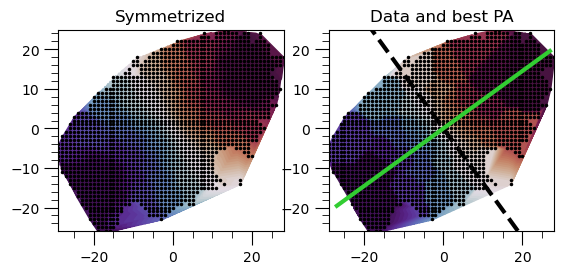Note:
This page was generated from a Jupyter notebook which can be found at
docs/tutorial_notebooks/1_data_prep_for_gauss_hermite.ipynb
in your DYNAMITE directory.
—-
1. Data Preparation for Gauss Hermite kinematics¶
This notebook shows how to prepare input kinematic data files from Gauss-Hermite files from the CALIFA and ATLAS-3D surveys.
It uses the example script for data preparation dynamite/data_prep/generate_kin_input.py which works for 4 Gauss-Hermite coefficients out of the box and hence would need to be modified for a different number of coefficients. Also, in case of CALIFA data, the script’s read_califa(file) method forces the errors to fulfil dvel ≥ 1, dsig ≥ 1, dh3 ≥ 0.005, and dh4 ≥ 0.005 and corrects negative sigma values.
Run this notebook from the directory docs/tutorial_notebooks.
First, import some modules…
[1]:
import os
import dynamite as dyn
CALIFA¶
Example galaxy: NGC 6278. A Schwarzschild model for this galaxy can be found in Zhu et al. (2018).
[2]:
from dynamite.data_prep.generate_kin_input import create_kin_input
# Input directory
in_dir = 'NGC6278_input/'
# The CALIFA stellar kinematic file for NGC 6278 can be found here:
in_file = 'NGC6278_input/NGC6278.V1200.rscube_INDOUSv2_SN20_stellar_kin.fits'
# The output will be placed here:
out_dir = 'NGC6278_input/dynamite_input/'
if not os.path.exists(out_dir):
os.makedirs(out_dir)
# Convert file to ECSV, fit the kinematic PA,
# write aperture.dat and bins.dat files
create_kin_input('NGC6278', in_file, out_dir, expr='',
fit_PA=True, kin_input='CALIFA')
# Add the PSF to the header of the kinematic file
gh = dyn.kinematics.GaussHermite()
gh.add_psf_to_datafile(sigma=[1.06], weight=[1.0],
datafile=f'{out_dir}/gauss_hermite_kins.ecsv')
Galaxy: NGC6278
NGC6278_input/NGC6278.V1200.rscube_INDOUSv2_SN20_stellar_kin.fits
Kin PA: 126.0 +/- 1.2 (3*sigma error)
Velocity Offset: -12.33
The pixel size is 1.0
PA: 126.0
Total bins: 152
Pixel grid dimension is 58.0 52.0
Vels plot: 197.20913252580198, 65.0832933754251, 218.18955410204666


The directory NGC6278_input/dynamite_input should now contain the following files:
mge.ecsv(this file was already present)gauss_hermite_kins.ecsvaperture.datbins.dat
together with some diagnostic plots. These files are the complete input needed to run DYNAMITE!
ATLAS 3D¶
Example galaxy: NGC 4570. Schwarzschild models for this galaxy can be found in Thater et al. (2019).
[3]:
from dynamite.data_prep.generate_kin_input import create_kin_input
# Input directory
in_dir = 'NGC4570_input/'
# For ATLAS3D data, two input/files are needed: the original cube and
# the kinematics cube. They can be found here:
in_files =[in_dir+'MS_NGC4570_r1_C2D.fits',
in_dir+'NGC4570_4moments_ATLAS3d.fits']
# The output will be placed here:
out_dir = 'NGC4570_input/dynamite_input/'
if not os.path.exists(out_dir):
os.makedirs(out_dir)
# Convert file to ECSV, fit the kinematic PA,
# write aperture.dat and bins.dat files
create_kin_input('NGC4570', in_files, out_dir, expr='',
fit_PA=True, kin_input='ATLAS3D', ngh=6)
# Add the PSF to the header of the kinematic file
gh = dyn.kinematics.GaussHermite()
gh.add_psf_to_datafile(sigma=[1.5], weight=[1.0],
datafile=f'{out_dir}/gauss_hermite_kins.ecsv')
Galaxy: NGC4570
['NGC4570_input/MS_NGC4570_r1_C2D.fits', 'NGC4570_input/NGC4570_4moments_ATLAS3d.fits']
Kin PA: 158.0 +/- 1.8 (3*sigma error)
Velocity Offset: -4.51
The pixel size is 0.7999992370605469
PA: 158.0
Total bins: 1517
Pixel grid dimension is 45.0 56.0
Vels plot: 160.14156677246095, 84.57122650146485, 168.83672607421877


The directory NGC4570_input/dynamite_input should now contain the following files:
gauss_hermite_kins.ecsvaperture.datbins.dat
together with some diagnostic plots. These files are your kinematic input for DYNAMITE. In addition, you will only need a file containing a Multi Gaussian Expansion (MGE) describing the stellar surface density of the galaxy.
Preparing other Gauss Hermite data files¶
To prepare DYNAMITE input from other surveys, or from your own fits, we recommend looking at the functions defined in dynamite/data_prep/generate_kin_input.py and adjusting them to your needs.
The file aperture.dat contains the spatial extent in arcseconds, the angle (in degrees) 90 - position_angle, and the size of the grid in pixels:
#counter_rotation_boxed_aperturefile_version_2
min_x min_y
max_x max_y
90.-position_angle
npix_x n_pix_y
The file bins.dat encodes the spatial (e.g. Voronoi) binning: specifically, it has one header line with the total number of pixels in the grid, followed by the bin ID of each pixel in the grid.
